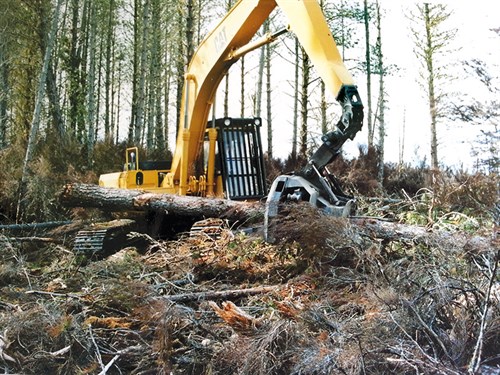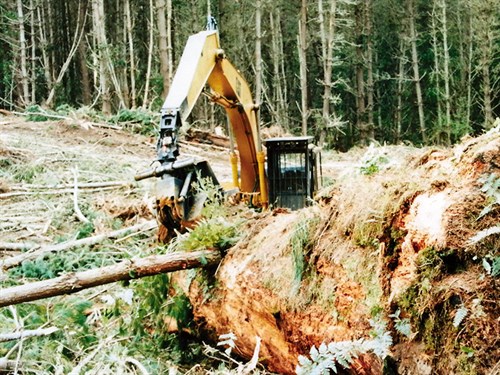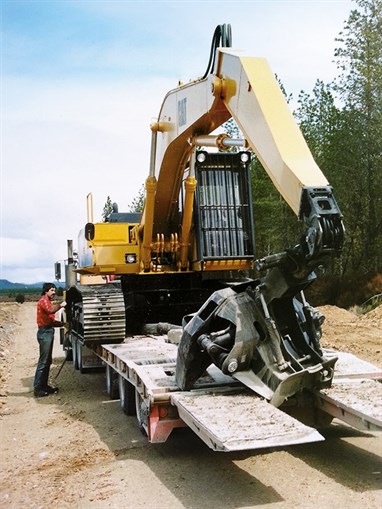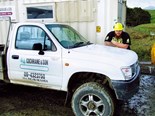Forestry: the perfectly built logging excavator
Every month I get a wind up from The Ed, because I'm always late with my article. I normally get: "Where's my story?" My response is always: "Gee I thought I had till next week."

Half the time I never have a subject and it was the same this month until a couple of days ago. While talking to a couple of brothers who run a successful logging operation in Northland, they told me that they were looking at upgrading their felling machine with a new one. What to buy and what is out there? Who designed what and for who? Do all the forestry machines that are for sale suit all types of logging operations? Not really.
Is this anyones fault? Maybe, so let us head back a few years to the start of mechanised felling in New Zealand. I am going to stick my neck on the block here, because I was responsible for putting the first commercial Hultdens 850 felling head into full time production in New Zealand. Previously we had snips, sheers, or the smaller 550 felling head used in minor species. The head was imported from Sweden and a 20-tonne standard long track frame excavator was chosen as the base machine. The initial application was just to fall minor species, Ponderosa, Corsican, Contorta and other small species of pine planted in Kaingaroa.
Ron Williams in Rotorua modified the excavator base. There was no blue print but we were taking advice from Michael, a Swedish operator that we brought over to help us with the set up and training. We took the ram of the top and attached this underneath the main boom and then onto the stick, this gave us the opportunity to run the hydraulic hoses down through the middle of the stick to the top of the felling head. A small modification was required at the end of the stick to hook the knuckle on.

Excavators then were just that, designed purely for civil construction, we had to add all the necessary hydraulics to allow the head to work. Remembering this was the first of its kind in New Zealand this was a big project and at the end of it we did not know if it would be successful or just a lemon, so many had already tried importing different European logging machines only to see them fail because they did not suit New Zealand conditions.
For added safety, we decided to build a protective structure over the cab; nothing was certified with a ROPS FOPS and all the other requirements in today's world. The only other modification was to add track guards, the rest of the excavator was factory standard sardine tin protection, this is how the first production mechanised felling machine was considered ready for work. The Hultdens 850 used a 404 harvester chainsaw chain and titanium bars. In the first few weeks we destroyed one bar a week and broke many chains, the machine proved a great success and was trialled felling trees of up to three tonne. Some trees were so big a scarf was required to get them on the ground. The 20-tonner could not lift them off the stump, so we would position the machine directly behind the tree and when we heard the saw break free, we would push it off the stump with the stick.
Because of the success of this machine, loggers started visiting to look for themselves and looked at putting their own machine in place with their own modifications and a lot of them got it wrong. One contractor decided on a short track frame and built the first high and wide ever seen. I was asked to demonstrate and teach him the felling techniques.
I questioned the need for high and wide and his answer was he did not want to get stuck on stumps. I did over 7500 hours on that first felling machine and not once was I stuck on a stump. All I had to do was put the head on the ground, lift my tracks off the ground and walk off the stump, easy. Still that was what he wanted; this was the most unstable machine I have ever operated. Every time I dropped a tree and slewed round to drop it on the heap, one track would come off the ground and by the end of the day it felt like I had been one big roller coaster ride.

So here we are in 2015, and still looking for the perfect felling machine. The machine suppliers have listened to the loggers and have gone away to develop and design what they think would meet the demand of the New Zealand market at some horrendous cost. Do they have it right? Yes, pretty much. After all, they have to develop a product for all of New Zealand, not just different provinces that have different conditions to others.
There is one area where I believe the manufacturers still have work to do, and I guess this is a cost issue.The basic high and wide forestry machine is still based on an excavator track gear no matter what the weight of the machine is. Excavators are designed to walk to a job stop, do the job and walk to the next job. They are not bulldozers that are designed to walk and work all day long. We have added extra heavy track gear and then want to walk these machines all day, my guess if you want good track life out of your excavator track gear then increase service intervals and preventative maintenance will be the way to go.
Loggers will always be looking for improvements in their machines. Some will still make costly mistakes but others will get it right. The best possible outcome from this is to learn from your mistakes and not repeat them; sometimes we have a habit of doing that. Will there ever be the perfect logging machine? I don't think so. If you put all the logging contractors in a room to design the prefect logging machine for New Zealand, they would still be there in a year's time trying to reach a consensus.
This year is almost over and it has been a good one with our injury count way down. That, at least, has got the unions and all the other hierarchy off our backs, with new safety legislation due to improve forestry safety. Let's hope it works. I am sure whatever the outcome, the logging contractors will continue to work to improve safety on their jobs so all those working in the industry were able to get home for Christmas.
Happy New Year to you all. Let's see what it brings.
Never miss one of Patrick Cox' forestry columns. Subscribe to our Deals On Wheels magazine here.
Keep up to date in the industry by signing up to Deals on Wheels' free newsletter or liking us on Facebook.








